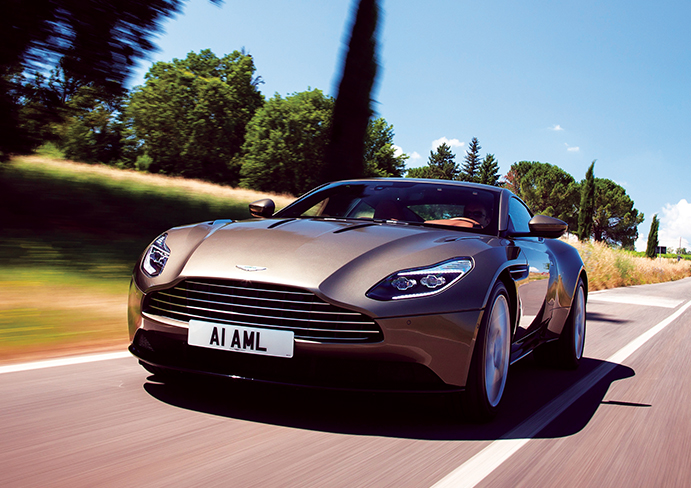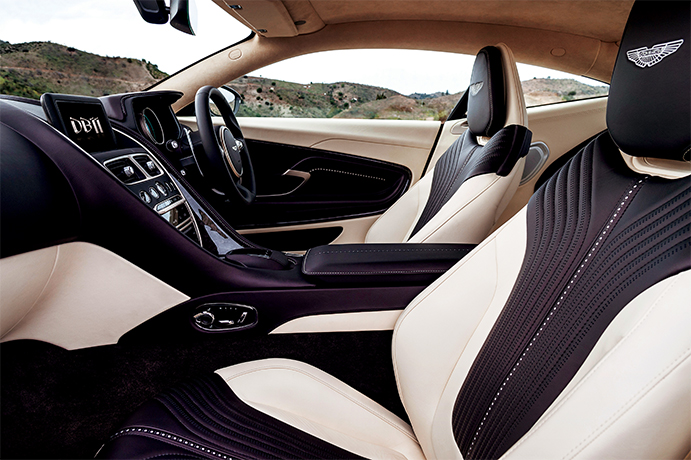
The DB11 marks the start of a brave new world for Aston Martin. Out goes the old VH platform that has underpinned most of the company’s models since 2003. The glorious naturally aspirated V12 that stretches back to the DB7 is gone now too (at least from this part of the range). In comes a new bonded aluminium chassis, plus an all-new 5.2-litre V12 sporting pair of twin-scroll turbochargers.
This is also the first product of a tie-up with Daimler. Aston Martin is at pains to point out that the engine and chassis – and indeed most of the other parts – have been designed and produced in-house. Nonetheless, there are elements, such as the heating ventilation and cooling (HVAC) system and the back end of the infotainment system, which do come from the German giant.
It feels like stepping into a different century if you swing open the door of the DB11, having come from one of its predecessors. There’s still an Aston Martin feel to the interior, with acres of leather and exquisite detailing, but it feels like it’s jumped several rungs on the evolutionary ladder.
The instrument cluster now takes the form of an 11in TFT LCD display. Fear not if that sounds a bit synthetic – it works brilliantly, and you would swear the 3D-rendered rev counter was the real thing until it subtly changes colour as you switch drive modes. It’s light years ahead of any other production Aston.

The other thing that strikes you is how roomy it is inside. It’s still a two-plus-two rather than a proper four-seater, but you can now get adults in the back. The front-seat accommodation is airier than other recent Astons.
To a certain degree that’s down to the DB11’s fundamental dimensions; it’s barely any bigger than the outgoing DB9 overall, but it features a longer wheelbase that frees up space in the cabin. The use of hot-quenching to form some of the pressed aluminium chassis members has helped here too. This allows the structural elements to be sculpted into complex shapes that mould around the cabin space rather than intruding upon it.
Thanks to this new platform, the body in white is 39 per cent stiffer and 21kg lighter than that of the DB9. This, according to Aston Martin, means the total weight is around the same (officially quoted at 1,770kg), despite the addition of twin turbos, two extra gearbox ratios and a whole load of additional tech.
Thumb the keyless start button on the centre console and the DB11 fires with an indulgent flare of revs. At a stroke, it silences one of the key concerns about the switch to forced induction; this still sounds like a proper V12, albeit slightly different to the old naturally aspirated engine.
Performance is every bit as mighty as you’d expect. The new unit produces 600bhp and no less than 700Nm of torque. According to Aston Martin’s figures, that translates to a 0-to-62mph time of 3.9 seconds and a top speed of some 200mph. But it’s the way that performance is delivered that defines the DB11.
There are vast reserves of torque from any speed in any gear – that much perhaps is to be expected from a large-capacity, turbocharged V12, but there’s also a real appetite for revs and no discernible lag. All the while, those 12 cylinders deliver a rich, multi-tonal soundtrack. True, it’s not quite as symphonic as the naturally aspirated V12 that still survives in the Vanquish and the Vantage, but it’s a world away from the one-dimensional growl of most modern turbo engines.
The DB11 uses a variant of the ubiquitous ZF eight-speed torque converter automatic, which can be found in everything from Audis to Rolls-Royces. A degree of customisation was required in this instance to package it into the Aston’s rear-mounted transaxle, but it was well worth it. The shifts are almost DSG-quick when you want them to be, but they’re also smooth and unobtrusive when you’re just gliding around.

I have to admit, we didn’t spend much time going slowly in our brief date with the DB11, but when you do back off to a cruise the engine dies down to virtual silence. There’s precious little wind or road noise either, which suggests long distances could be covered serenely if you wish.
Another interesting trick that’s employed to boost the Aston’s cruising credentials is cylinder deactivation. The big V12 is capable of shutting down six cylinders for extended periods at light loads. This helps the DB11 to achieve a claimed 24.8mpg on the combined cycle and 265g/km of CO2 – respectable figures for a 200mph grand tourer.
With the Bilstein adaptive dampers in the softest of their three settings the ride is cosseting. They use a valve-type adjustment, as opposed to the magnetorheological systems found on some rivals, and the result is a very wide operating range. Switch to Sport or Sport Plus and the whole chassis takes on a sharper edge, without sacrificing too much of the comfort.
At 13:1, the steering ratio is significantly quicker than that of the DB9 (or even the Vantage). It’s also Aston Martin’s first electrically assisted system. There’s a real delicacy and precision to its responses. For a car that does a pretty good impression of a luxury limo, the DB11 also feels remarkably lithe and alert.
At higher speeds, a host of clever aerodynamic devices help to keep things stable. The ‘curlicue’ vents down the sides, for instance, aren’t just for show. These vent pressure build-up in the front wheel arches to prevent lift, but the undersides also have a wavey pattern to spin the turbulent air into vortices as it exits, reducing drag.
Part of the design brief was to have a very clean silhouette with no visible spoilers. Instead, the rear of the car has what Aston Martin terms an AeroBlade. This is a discrete slit in the boot lid, which draws high-pressure air from a pair of vents in the rear buttresses and fires it upwards to create downforce. Above 96mph, a small Gurney flap deploys to further increase the effect, but the bodywork remains an almost seamless piece of automotive sculpture.
The real beauty of the DB11, however, is its breadth of ability. Here is a car that can cruise in comfort, thrill on twisty roads and (just about) seat four. It fulfils the GT role perfectly. And for Aston Martin that’s just the start. The same platform is set to spawn spin-offs, while a replacement for the smaller Vantage is also due next year. From what we’ve seen so far, the future looks very bright indeed.










Radio wave weapon knocks out drone swarms
I hope they have assessed how easy it is to shield a drone against the attack. Hopefully the shielding would add too much weight.